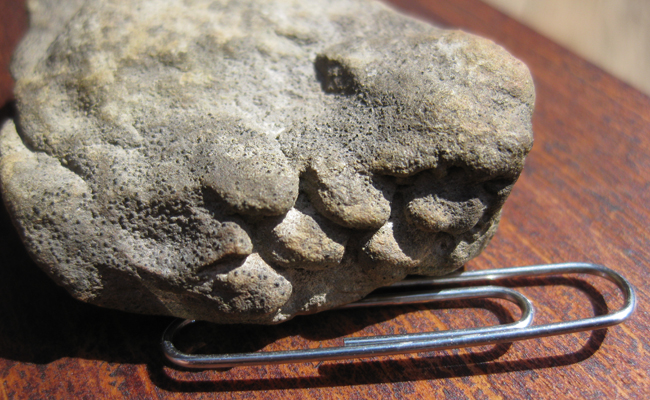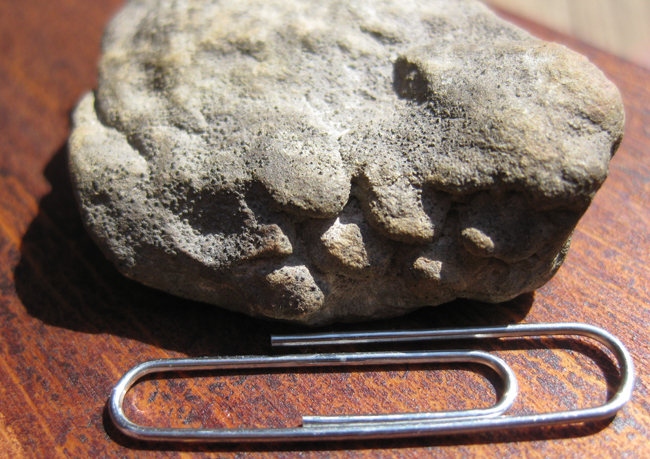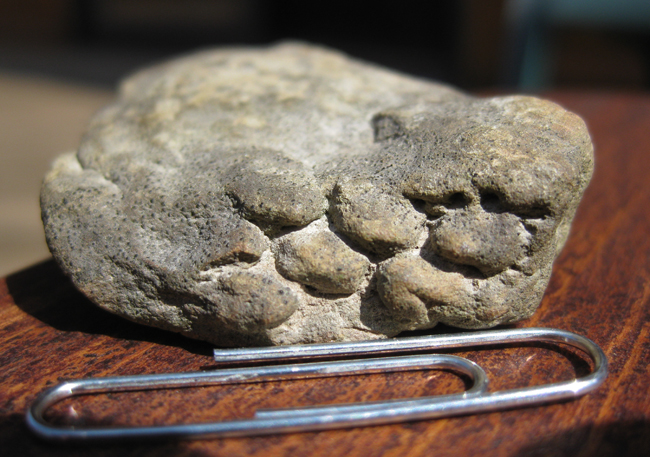A Fort Valley neighbor brought me this sample yesterday, asking me to tell her what it was. But while my brain’s pattern-recognition centers lit up when examining its “rows” of scale-like bumps, it didn’t match up with anything that I know from anywhere else here.
Take a look, and click any of these images to enlarge it…
The source unit is likely to be the Mahantango Formation, as that is most extensive in the middle of the Fort Valley, and it’s very fossiliferous in places. It’s Devonian in age. There were plenty of spiriferid brachiopods in several other samples she brought over, collected at the same location (her yard). She’s found four like this over the past couple of years…
So, Internet, make me glad I asked you: What is this?





From your photos, I don’t detect any sort of microstructure, so I’m guessing this thing is a cast (sediment infill) of a trace fossil, perhaps something along the lines of Bergaueria (see Google Images), which has a superficial resemblance to this, and is interpreted as resting places of anemones or some other coelenterate polyps. The main objection is that Bergaueria “bumps” are usually bigger than your specimen.
The bumps form a vague quincuncial pattern, but that may be simply a reflection of the most compact packing order of objects such as the putative Bergaueria-makers on the sediment surface.
Do you have a feeling for how those dark coloured “granules” are related to the specimen? Are they superficial (lichen?), something in the matrix (glauconite pellets?), or primary features of the fossil itself?
The only other thing I can think of is a sponge of some sort (but I don’t see any spicules in the close-up views), perhaps something along the lines of Solenopora (controversial origin, variously described as a calcareous alga or a sponge). A longitudinal section might shed some light on its ID.
I think the black dots are just small lichen colonies.
I often crowd-source fossils to http://www.reddit.com/r/fossilid/ with much success
I can only offer some observations that may not be relevant but the black granulation appears to be circular and distributed within the greyish areas and absent in the yellowish regions. I would be tempted to polish a small area in order to see what lies beneath.
I’m no paleo guy, but it just looks like imbricated pebbles to me…
It’s not. The bumps are the same fine grain size as the rest of the rock.
I know very little Devonian paleo…or sedimentology for that matter… perhaps something methodically munching on mud and casting off pellets?
otherwise – perhaps secondary (karst) feature formed prior to the piece of rock falling loose?
Cast of coral surface?
These appear to be loading structures caused by sand bulging down into the
underlying bed that has now been removed by erosion. They are unusually regular and similar in size, but I think that they still fit the diagnosis of load structures.
But Mark, look at their size! Not only are they the same shape and regularly spaced, they are only a few mm across! That’s unlike any loading-induced soft sediment deformation I’ve ever seen….
Callan, they are within the size range for load casts. In your lower image, structure on the right, you can even make out the radial stretch marks caused by the sand pressing into the bed below. In any case, an interesting specimen!
You should see what an ichnologist thinks about it, e.g. Tony Martin (http://www.georgialifetraces.com/blog/)
He did chime in already, on Twitter:
http://twitter.com/Ichnologist/status/321332517623955457
It is not necessarily a pseudofossil either, if there was, as seems likely, a biomat film between the sagging sand bed and the bed below. Anthony Martin’s suggestion that it might be a plug-burrow is also possible, but like him I would like to see more specimens.
I’m with Mark M. on this.
As Howard noticed, it superficially resembles Solenopora, but, if it were, some structure should be visible. It is very similar to some of the Ordovician algal balls that I have seen???
Found similar specimens this week in far eastern Nevada associated with limestone and mudstone formations. Fossils in area appear to be various sponges, Ammonites and bivalves.